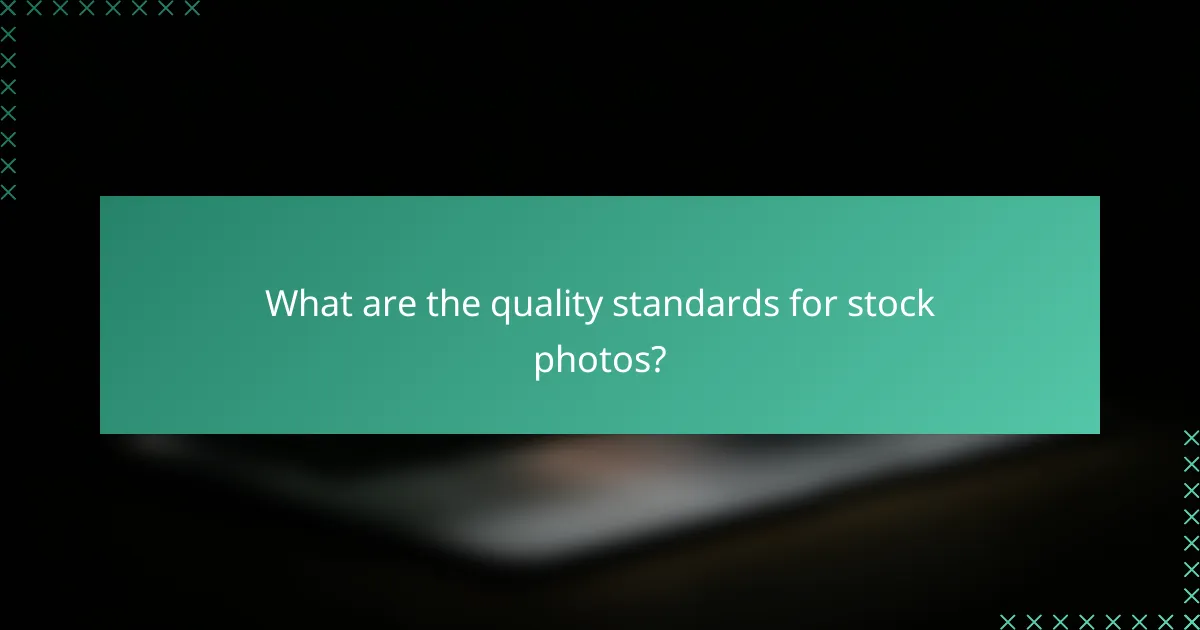Stock photos are essential resources for various projects, and understanding the different licensing types is crucial for effective use. In Canada, options such as royalty-free, rights-managed, and Creative Commons licenses cater to diverse needs and budgets. Additionally, adhering to quality standards ensures that images meet the necessary criteria for professional use, while exploring niche markets can enhance the relevance and impact of your visual content.

What are the types of stock photo licenses available in Canada?
In Canada, stock photo licenses primarily include royalty-free, rights-managed, editorial use, Creative Commons, and exclusive licenses. Each type has distinct usage rights, restrictions, and pricing structures that cater to different needs and budgets.
Royalty-free licenses
Royalty-free licenses allow users to pay a one-time fee to use the image without ongoing royalties. This means you can use the photo multiple times across various projects without incurring additional costs. However, it’s important to check the specific terms, as some restrictions may apply regarding resale or redistribution.
These licenses are popular among marketers and businesses due to their affordability and flexibility. Many stock photo websites in Canada offer a wide range of royalty-free images suitable for both commercial and personal use.
Rights-managed licenses
Rights-managed licenses provide specific usage rights for a set duration and purpose, often at a higher price point. Users must specify how they intend to use the image, and the cost may vary based on factors like the size of the audience or the duration of use. This type of license is ideal for businesses that require exclusive rights for a particular campaign.
Since rights-managed licenses are more restrictive, they can offer a greater level of protection against competition using the same images. However, this means you may need to budget more for these licenses compared to royalty-free options.
Editorial use licenses
Editorial use licenses restrict images to non-commercial purposes, such as news articles, blogs, or educational materials. These images cannot be used for advertising or promotional content, which makes them suitable for journalists and content creators focused on reporting or commentary.
When using editorial images, ensure that the context aligns with the licensing terms. Misusing these images in a commercial context can lead to legal issues, so always verify the license details before use.
Creative Commons licenses
Creative Commons licenses allow creators to share their work with varying levels of restrictions. Some licenses permit commercial use, while others require attribution or prohibit modifications. In Canada, many photographers use Creative Commons to promote their work while retaining certain rights.
When using Creative Commons images, it’s crucial to adhere to the specific conditions outlined in the license. This can include giving proper credit to the creator or ensuring that the image is not altered if the license prohibits modifications.
Exclusive licenses
Exclusive licenses grant a single user the rights to a photo, preventing others from using the same image. This type of license often comes at a premium price, making it suitable for brands that want to maintain a unique visual identity.
When considering an exclusive license, evaluate the potential return on investment. If the image is critical to your brand’s marketing strategy, the higher upfront cost may be justified by the exclusivity it provides.

How to choose the right stock photo license?
Choosing the right stock photo license involves understanding your specific usage needs, budget constraints, and the level of image exclusivity required. Each license type offers different rights and limitations, so it’s essential to align them with your project goals.
Assessing usage needs
Begin by clearly defining how you plan to use the stock photos. Common usage scenarios include online marketing, print materials, or social media content. Each of these may require different licensing terms, such as whether the images will be used commercially or for personal projects.
For instance, if you need images for a commercial website, you might require a broader license that allows for distribution and modification. Conversely, personal use might only necessitate a more limited license.
Understanding budget constraints
Budget is a critical factor when selecting a stock photo license. Prices can vary significantly based on the type of license, the source of the images, and the intended use. Stock photo sites often offer subscription models or pay-per-image options, which can help manage costs.
Consider setting a budget range for your stock photo needs. For example, you might allocate a few hundred USD for a small project or several thousand for a larger campaign. Always compare the costs of different licenses to find the best fit for your financial situation.
Evaluating image exclusivity
Image exclusivity refers to whether you have sole rights to use a particular photo. Exclusive licenses can be significantly more expensive but may be worth the investment if you want to ensure that your visuals are unique to your brand.
When evaluating exclusivity, weigh the benefits against the costs. If your project is highly competitive, investing in exclusive rights may provide a strategic advantage. However, for less competitive uses, a non-exclusive license may suffice and save you money.

What are the quality standards for stock photos?
Quality standards for stock photos ensure that images meet specific criteria for resolution, color accuracy, composition, and file format. Adhering to these standards is crucial for satisfying both buyers’ needs and licensing requirements.
Resolution requirements
Resolution is a key factor in determining the usability of stock photos. Most stock photo platforms require images to have a minimum resolution of 300 DPI (dots per inch) for print quality, while 72 DPI is often sufficient for web use. High-resolution images allow for larger prints and better detail, making them more appealing to buyers.
When submitting images, consider providing multiple resolutions to cater to different needs. For instance, offering both high-resolution files for print and lower-resolution files for online use can enhance your portfolio’s versatility.
Color accuracy
Color accuracy is essential for ensuring that the colors in stock photos appear true to life. Images should be captured and edited in a color space like Adobe RGB or sRGB to maintain consistency across various devices. Buyers often seek images that reflect accurate colors to match their branding or design needs.
To achieve color accuracy, use calibrated monitors during editing and consider including color profiles with your images. This practice helps maintain the intended look of the photo when viewed on different screens or printed.
Composition guidelines
Good composition enhances the visual appeal of stock photos and makes them more marketable. Common guidelines include the rule of thirds, leading lines, and balanced framing. These techniques help create engaging images that draw viewers’ attention.
Additionally, consider the intended use of the photo. For example, leave ample negative space for text overlays in marketing materials. Understanding the needs of potential buyers can guide your composition choices.
File format specifications
File format plays a significant role in the quality and usability of stock photos. Common formats include JPEG for general use, PNG for images requiring transparency, and TIFF for high-quality prints. Each format has its advantages and limitations, so choose based on the intended application.
When submitting images, check the specific requirements of the stock photo platform. Some may have restrictions on file size or format, while others might offer recommendations for optimal quality. Adhering to these specifications can help improve your images’ acceptance rates.

Which stock photo platforms are popular in Canada?
In Canada, popular stock photo platforms include Shutterstock, Adobe Stock, iStock, and Getty Images. Each platform offers unique features, licensing options, and image quality standards that cater to various needs.
Shutterstock
Shutterstock is one of the leading stock photo platforms, known for its extensive library of over hundreds of millions of images. It offers flexible subscription plans and on-demand image packs, making it suitable for both individuals and businesses.
When using Shutterstock, consider the licensing options available, which range from standard to enhanced licenses. The standard license covers most uses, while the enhanced license allows for broader applications, such as merchandise and advertising.
Adobe Stock
Adobe Stock integrates seamlessly with Adobe Creative Cloud applications, making it a popular choice for designers and creatives. With millions of high-quality images, videos, and templates, it caters to a wide range of creative projects.
Adobe Stock offers subscription plans and credit packs, allowing users to purchase images as needed. Be mindful of the licensing terms, as they vary based on the type of subscription and intended use.
iStock
iStock, a subsidiary of Getty Images, provides a diverse collection of stock photos, illustrations, and videos. It offers both standard and exclusive content, appealing to different market segments.
Users can choose between credit-based purchases or subscription plans. The pricing structure can vary significantly, so it’s essential to evaluate your specific needs and budget when selecting images from iStock.
Getty Images
Getty Images is renowned for its premium quality and editorial content, making it a go-to platform for media professionals. It offers a vast selection of images, including historical and contemporary photographs.
Getty Images operates on a more traditional licensing model, with options for rights-managed and royalty-free images. This means users should carefully review the licensing agreements to ensure compliance with usage rights, especially for commercial projects.

What niche markets benefit from stock photos?
Niche markets that benefit from stock photos include real estate, travel, food, and wellness industries. These sectors utilize high-quality images to enhance marketing efforts, attract customers, and convey specific themes or emotions.
Real estate marketing
Real estate marketing heavily relies on stock photos to showcase properties effectively. High-quality images of homes, interiors, and neighborhoods can significantly impact buyer interest and engagement. Using appealing visuals helps create a strong first impression, which is crucial in a competitive market.
When selecting stock photos for real estate, consider the target audience and the type of properties being marketed. For instance, luxury homes may require more polished, upscale images, while affordable housing might benefit from relatable, everyday visuals. Always ensure that the photos reflect the actual properties to avoid misleading potential buyers.
Additionally, using local imagery can enhance relatability. For example, if marketing a property in Sofia, Bulgaria, incorporating images that highlight local architecture or popular neighborhoods can resonate more with prospective buyers. Aim for a mix of exterior shots, interior spaces, and lifestyle images to create a comprehensive view of the property.
